CPS Unit Number 018-01
Camp: 18
Unit ID: 1
Operating agency: MCC
Opened: 8 1941
Closed: 9 1946
Workers
Total number of workers who worked in this camp: 714
-
 Civilian Public Service Camp #18, Denison, IowaBuilding DamDigital image at Mennonite Church USA Archives, North Newton, Kansas
Civilian Public Service Camp #18, Denison, IowaBuilding DamDigital image at Mennonite Church USA Archives, North Newton, Kansas -
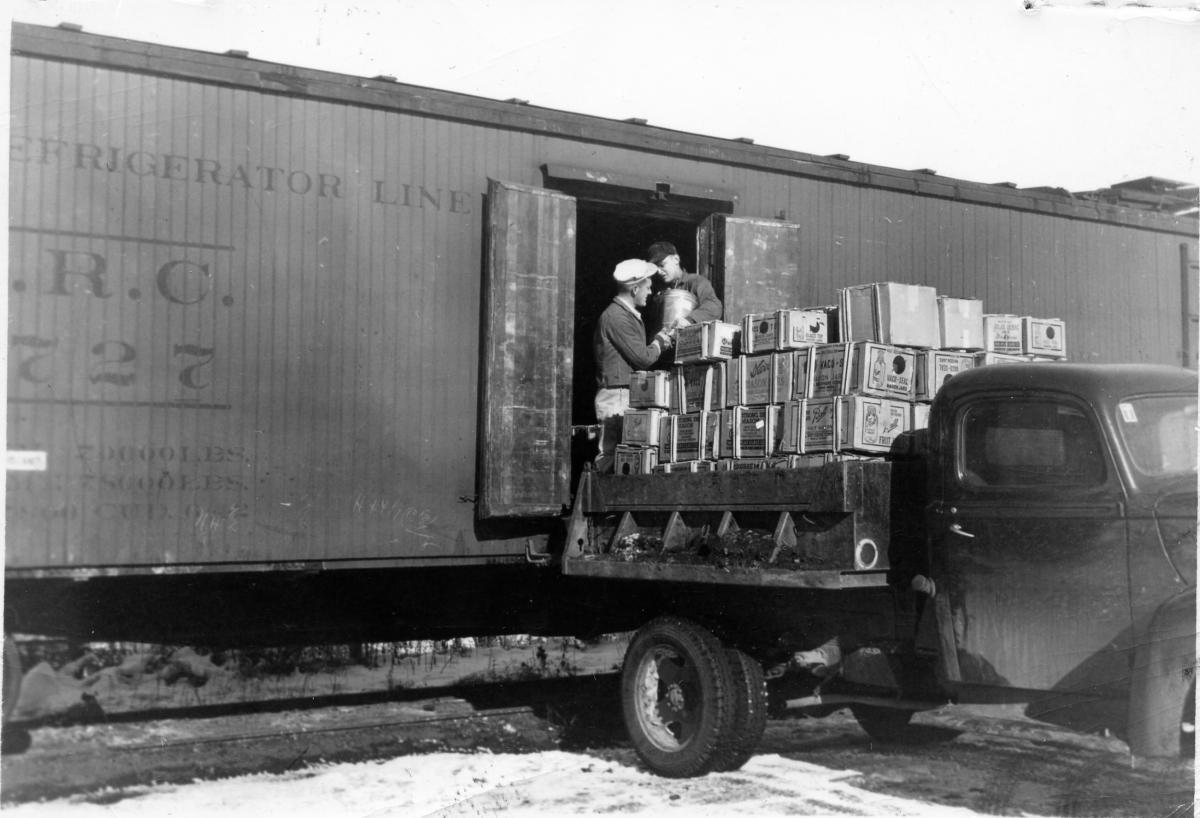 CPS Camp # 18, Denison, IowaLoading refrigerator railroad cars with canned goods "from center" at the camp.Digital Image at Mennonite Church USA Archives, North Newton, Kansas
CPS Camp # 18, Denison, IowaLoading refrigerator railroad cars with canned goods "from center" at the camp.Digital Image at Mennonite Church USA Archives, North Newton, Kansas -
 CPS Camp No. 18, Denison, Iowa.Civilian Public Service workers filling sand bags. Civilian Public Service workers filled up sand bags to save Council Bluffs, Iowa from the Missouri River flood, April 1943. In the background are the sand bags to protect the pumping station, the sole source of water fort he city of 40,000 residents. By way of thanks, the city engineer Jack Boyne offered them to see a show at the theatre, then cigarettes, then beer: all refused by the CPS men who then asked for two new aprons and four dish towels for the cooks at CPS Camp Denison, Iowa, items which were then promptly provided.Digital image, Photo #61. Box 1, Folder 5. MCC Photographs, Civilian Public Service, 1941-1947. IX-13-2.2. Mennonite Central Committee Photo Archive
CPS Camp No. 18, Denison, Iowa.Civilian Public Service workers filling sand bags. Civilian Public Service workers filled up sand bags to save Council Bluffs, Iowa from the Missouri River flood, April 1943. In the background are the sand bags to protect the pumping station, the sole source of water fort he city of 40,000 residents. By way of thanks, the city engineer Jack Boyne offered them to see a show at the theatre, then cigarettes, then beer: all refused by the CPS men who then asked for two new aprons and four dish towels for the cooks at CPS Camp Denison, Iowa, items which were then promptly provided.Digital image, Photo #61. Box 1, Folder 5. MCC Photographs, Civilian Public Service, 1941-1947. IX-13-2.2. Mennonite Central Committee Photo Archive -
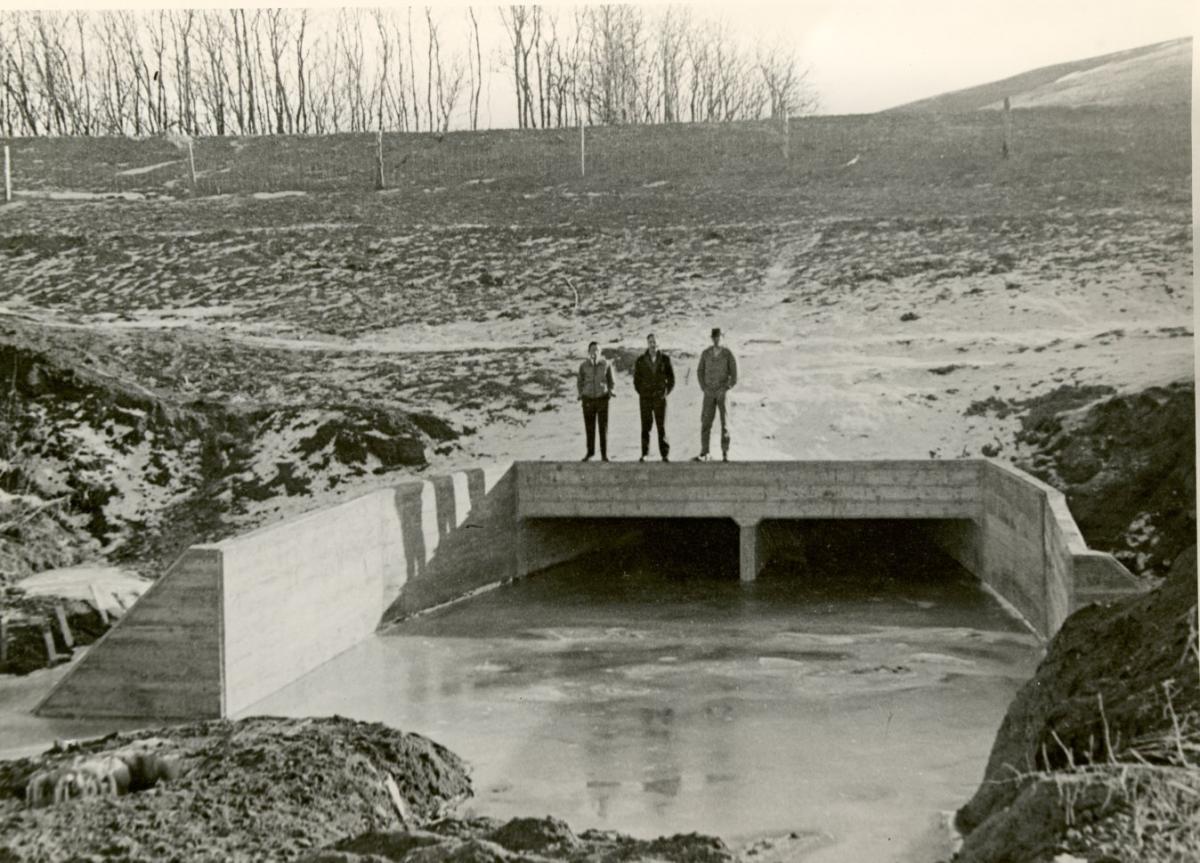 CPS Camp # 18 Denison, IowaAfter completion-this was the largest structure built by crews from Denison Camp-contents 550 cubic yards of concrete-earth fill, some 20,000 cubic yards. Left to right: Walter Lohrenz, McPherson, Kans, Coleman Nogrady, Appleton, Wisc., and Randy Penner, Newton, Kans.Photo # 5-b. Box 1, Folder 12. MCC Photographs, Civilian Public Service, 1941-1947. IX-13-2.2. Mennonite Central Committee Photo Archive
CPS Camp # 18 Denison, IowaAfter completion-this was the largest structure built by crews from Denison Camp-contents 550 cubic yards of concrete-earth fill, some 20,000 cubic yards. Left to right: Walter Lohrenz, McPherson, Kans, Coleman Nogrady, Appleton, Wisc., and Randy Penner, Newton, Kans.Photo # 5-b. Box 1, Folder 12. MCC Photographs, Civilian Public Service, 1941-1947. IX-13-2.2. Mennonite Central Committee Photo Archive -
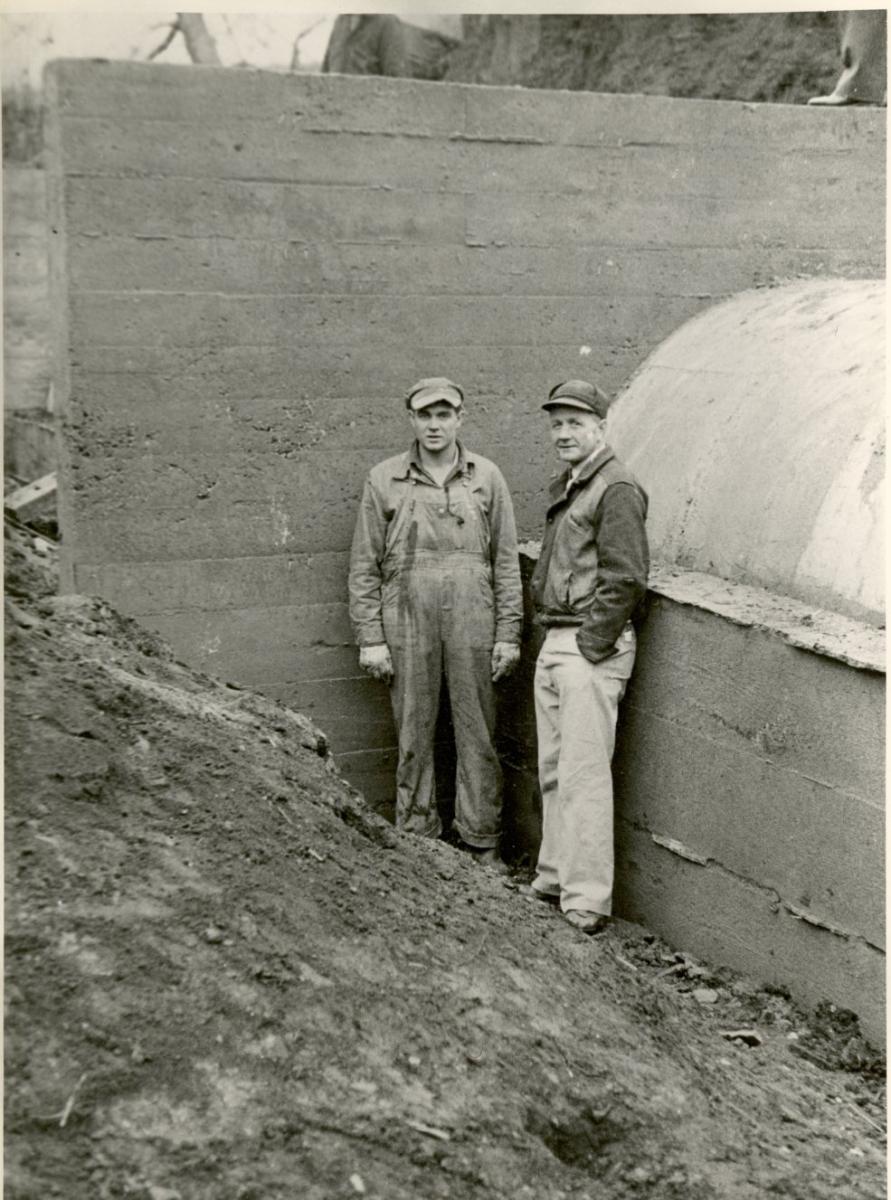 CPS Camp # 18, Denison, IowaProject: 6' road culvert with riser, adjacent to James Siegner from Crawford Co., Ia. Left to right: Milburn Norris, LaGrange Ind. CPS foreman; Floyd Nimmo, Camp technicianPhoto # 4. Box 1, Folder 10. MCC Photographs, Civilian Public Service, 1941-1947. IX-13-2.2. Mennonite Central Committee Photo Archive.
CPS Camp # 18, Denison, IowaProject: 6' road culvert with riser, adjacent to James Siegner from Crawford Co., Ia. Left to right: Milburn Norris, LaGrange Ind. CPS foreman; Floyd Nimmo, Camp technicianPhoto # 4. Box 1, Folder 10. MCC Photographs, Civilian Public Service, 1941-1947. IX-13-2.2. Mennonite Central Committee Photo Archive. -
 CPS Camp # 18, Denison, IowaReinforced inlet riser-Clarence Moyer, Camp Superintendant standing near structurePhoto # 4-a. Box 1, Folder 12. MCC Photographs, Civilian Public Service, 1941-1947. IX-13-2.2.Mennonite Central Committee Photo Archive
CPS Camp # 18, Denison, IowaReinforced inlet riser-Clarence Moyer, Camp Superintendant standing near structurePhoto # 4-a. Box 1, Folder 12. MCC Photographs, Civilian Public Service, 1941-1947. IX-13-2.2.Mennonite Central Committee Photo Archive -
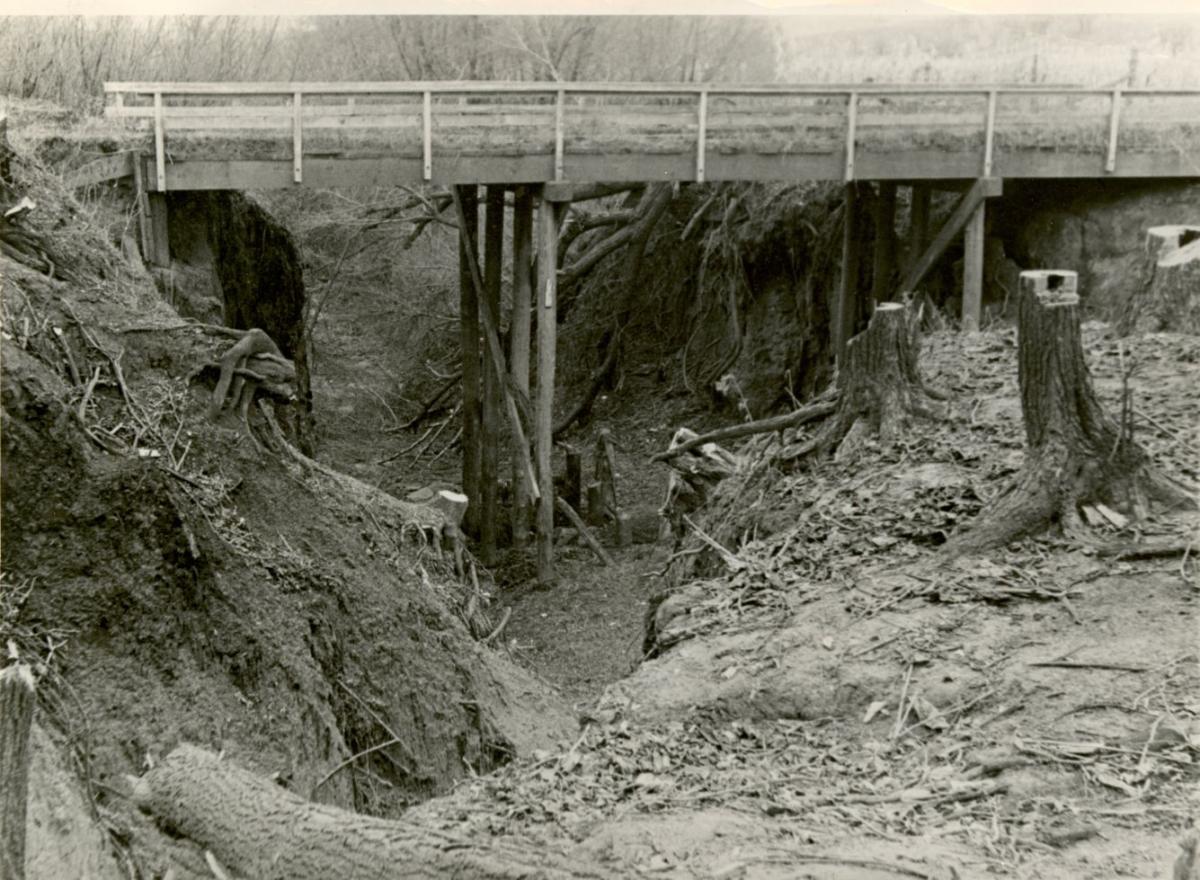 CPS Camp # 18, Denison, IowaBefore-showing bridge undercut by erosion. Drop inlet road structure and fill adjacent to Stepanek Farm, Crawford Co., IA. Twin 5 X 5 culvert.Photo # 5-1. Box 1, Folder 12. MCC Photographs, Civilian Public Service, 1941-1947. IX-13-2.2. Mennonite Central Committee Photo Archive
CPS Camp # 18, Denison, IowaBefore-showing bridge undercut by erosion. Drop inlet road structure and fill adjacent to Stepanek Farm, Crawford Co., IA. Twin 5 X 5 culvert.Photo # 5-1. Box 1, Folder 12. MCC Photographs, Civilian Public Service, 1941-1947. IX-13-2.2. Mennonite Central Committee Photo Archive -
 CPS Camp No. 18Pouring cement for soil erosion control at CPS Camp 18.From the private collection of Leo Harder, licensed under Creative Commons Attribution Share-Alike 2.5
CPS Camp No. 18Pouring cement for soil erosion control at CPS Camp 18.From the private collection of Leo Harder, licensed under Creative Commons Attribution Share-Alike 2.5 -
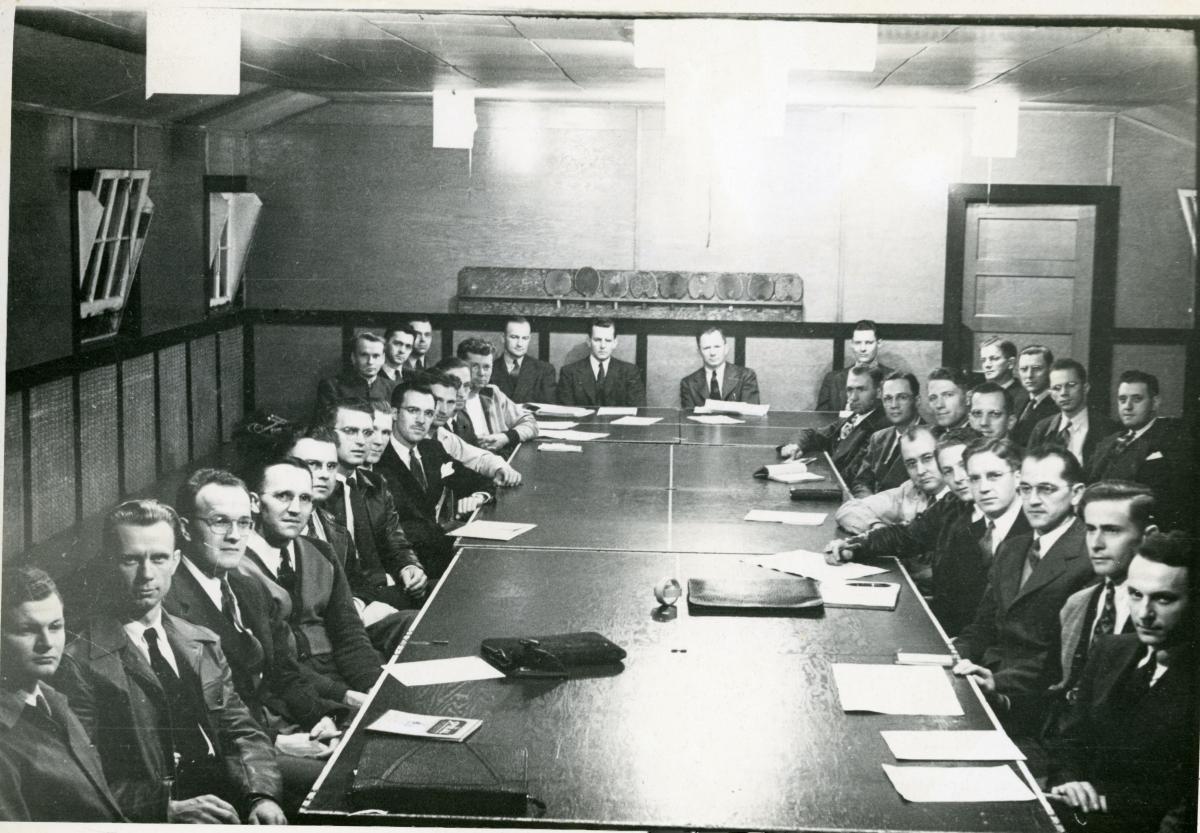 Civilian Public Service (CPS) Directors' Conference, with CPS Camp # 18, Denison, Iowa(Persons, clockwise, inner row, left-right): 1. Arthur Wiebe, 2. Jesse Harder, 3. Robert S. Kreider, 4. Ralph Hernley, 5. Art Balzer, 6. (unidentified), 7. Henry Guhr, 8. Ed Belan, 9. (unidentified), 10. (unidentified), 11. (unidentified), 12. Ralph Beechy, 13. Rufus Franz, 14. Albert Gaeddert, 15. Erwin W.Goering, 16. (unidentified), 17. Roy Umble, 18. Henry Reimer, 19. Harold Martin. 20. Leland Brenneman, 21. Orin Beechy, 22. Lester Gerig (or Russell Massanari), 23. Dwight Yoder, 24. Alfred G. Zook, Atlee Beechy. (Outer row, left side, left-right) 26. Grant Stoltzfus, 27. Harold Mishler, 28. Donald Gundy. (Outer row, right side, left-right): 29. David H. Suderman, 30. Jacob D. Goering, 31. Elmer M. Ediger, 32. Russell Massanari (or Lester Gerig). [Identification by Robert S. Kreider and H. King, 1990].Mennonite Central Committee Archival Photo1945
Civilian Public Service (CPS) Directors' Conference, with CPS Camp # 18, Denison, Iowa(Persons, clockwise, inner row, left-right): 1. Arthur Wiebe, 2. Jesse Harder, 3. Robert S. Kreider, 4. Ralph Hernley, 5. Art Balzer, 6. (unidentified), 7. Henry Guhr, 8. Ed Belan, 9. (unidentified), 10. (unidentified), 11. (unidentified), 12. Ralph Beechy, 13. Rufus Franz, 14. Albert Gaeddert, 15. Erwin W.Goering, 16. (unidentified), 17. Roy Umble, 18. Henry Reimer, 19. Harold Martin. 20. Leland Brenneman, 21. Orin Beechy, 22. Lester Gerig (or Russell Massanari), 23. Dwight Yoder, 24. Alfred G. Zook, Atlee Beechy. (Outer row, left side, left-right) 26. Grant Stoltzfus, 27. Harold Mishler, 28. Donald Gundy. (Outer row, right side, left-right): 29. David H. Suderman, 30. Jacob D. Goering, 31. Elmer M. Ediger, 32. Russell Massanari (or Lester Gerig). [Identification by Robert S. Kreider and H. King, 1990].Mennonite Central Committee Archival Photo1945 -
 CPS Camp # 18 QuartetLeft to Right: Henry Schultz, Mt. Lake, Minn., Clarence Friesen, Henderson, Neb., Russel Massanari, Fisher, Ill., John Schutlz [sic], Mt. Lake, Minn.Mennonite Central Committee Archival Photo
CPS Camp # 18 QuartetLeft to Right: Henry Schultz, Mt. Lake, Minn., Clarence Friesen, Henderson, Neb., Russel Massanari, Fisher, Ill., John Schutlz [sic], Mt. Lake, Minn.Mennonite Central Committee Archival Photo -
 CPS Camp # 18CPS Camp # 18Mennonite Central Committee Archival Photo
CPS Camp # 18CPS Camp # 18Mennonite Central Committee Archival Photo
-
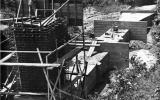
-
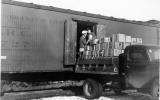
-
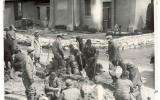
-
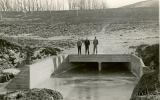
-
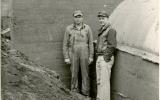
-
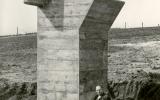
-
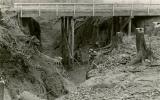
-
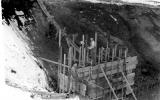
-
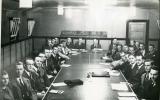 1945
1945 -
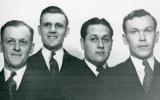
-
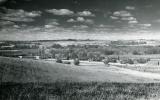
CPS Camp No. 18, a Soil Conservation Service base camp located in a former Civilian Conservation Corps camp in Denison, Iowa and operated by Mennonite Central Committee, opened in August 1941 and closed in September 1946. The men built concrete dams to arrest gully and other erosion.
The former Civilian Conservation Corps (CCC) camp had been used by CCC war veterans up to the day before seventy-two CPS men arrived. It was forty miles east of the Missouri River, seventy-five miles northeast of Omaha on US 30 (also known as the Lincoln Highway), and about a mile southwest of Denison. The physical plant, viewed as one of the best, had seven dormitories, a dining hall, staff cottage, bath house, chapel, combination laundry-drying and storage facility, shop, hospital and office building. All were arranged around a beautiful lawn with walkways and flower beds.
Directors: Gideon Yoder, Paul Bender, Arnold Krause, Wilbur Nachtigal, Lester Greig, Paul Troyer, John Siemens, Maynard Book, Gilbert Alliman
Dietician: Katie Yoder, Lena Pauls, Mrs. Victor Janzen
Matron: Alta Schrock, Alieda Schrag
Nurse-Matron: Helen Regier, Edna Peters, Thelma Gratz
One hundred-fifty men served at Denison. In June 1943, the largest proportion of men reported to CPS from Indiana. The men in the Indiana group averaged twenty-three years in age, were single, farmers, had an 8th grade education, and belonged to the General Conference Mennonite Church.
However, in total, men came from nine states, had been engaged in fourteen different occupations prior to entering camp. The age ranged more broadly as four were nineteen years of age but two were above forty-two years old. Three men had four years or more of college.
Light silt loam soils in the Denison area on hills with grades of fifteen percent, had resulted in gully and sheet erosion. The men built concrete dams to arrest the gullies, and this work required excavation with pick and shovel. They also terraced the hills, planted trees, and seeded waterways in more seriously eroded areas.
“A summary of total work done appearing in the January, 1944 camp paper showed that the men built 14,889 rods of fence, sloped 347,683 square yards of banks, erected 26 structures and earth fills, seeded and sodded 20,198 square yards of water-ways, built 17,710 linear feet of diversion dikes, improved 64 acres of forest stands, and spent 16,580 service days in surveying, maintaining the camp, farm work, and flood control.” (Gingerich p. 116)
The men protected Council Bluffs in the April 1943 flood of the Missouri River, resulting in favorable publicity. For ten days the men piled sand bags along the Missouri River working with hundreds of volunteers. The city engineer visited their barracks to personally thank them for their contribution. (Keim p. 99)
Denison also organized a food collection and relief center serving not only camps between the Rocky Mountains and the Mississippi, but also the needy in Denison.
Prior to locating the camp in Denison, responsible groups of the community expressed no objection to a camp of conscientious objectors. However, that did not prevent some in 1942 from concluding the COs were not welcome in town. The feelings abated as farmers relied on help from the campers in improving the land. In addition, wives of campers who were employed in homes in Denison did much to build good community relations.
Alta Schrock served on the camp staff as matron for the first month. Katie Yoder was the first dietician, Delvin C. Kirchhofer the first educational director, and Willard Baer the first business manager.
Brig. Gen. Lewis B. Hershey came to the camp on November 1, 1941, visiting with the men and touring the camp.
Edwin J. Schrag described his experience at Denison, his first CPS assignment.
The man who was running the CPS camp was looking for someone to manage the books. Since I had taken a bookkeeping class in high school, I became the bookkeeper. I was one of few boys there with much education. There were Amish and Old Mennonites who had very little schooling. . . . It was while I was in Denison that the December 7 bombing of Pearl Harbor occurred. Morale got really low at that time because we knew then that we were in for the duration of the war. (The Eden Peace Witness: A Collection of Personal Accounts pp. 134-135)
Two years later when Dr. George A. Buttrick, minister of the Madison Avenue Presbyterian Church in New York City visited the camp and the town, his message emphasized that in church, differences in status, education, age, and race were not barriers to fellowship. Further, he shared that he was a conscientious objector and that two of his sons were serving in CPS camps.
The men published a camp paper beginning October 7, 1941. It was first called Olive Branch, then in June 1942 it was renamed The Olive Twig. After several years, the paper became The Vanguard and published under that name from October 1944 through May 1946.
Denison offered classes in foreign relief and rehabilitation in preparation for service abroad. James Clemens taught French and German in that unit while serving at the camp.
The educational program included informal classes, social activities, the camp monthly publication and worship planning. Several men served as educational director during the camp’s operation. One educational director, Roy Umble, after leaving Denison to serve at MCC headquarters in Akron, Pennsylvania, “. . . served as a link between CPS units and Mennonite colleges”.
MCC had received permission to use the civilian form of USAFI [U.S. Armed Forces] General Educational Development tests. Scores on these tests enabled some men to receive high school and college credit even without formal education beyond eighth grade.
To satisfy procedures for granting academic credit Paul Bender, Goshen College registrar, and I kept records of all courses taught in mental hospitals and relief training units—foreign languages, work project studies and preparation for relief service. (“Detour. . .Main Highway”: Our CPS Stories pp. 61-63)
In June 1945 David Kope conducted a three-week craft school at Denison. Men from Denison and three other camps (Colorado Springs, Fort Collins and Hill City) trained to serve as craft leaders. Edna Quiring taught arts and crafts in the camps beginning in October 1945. Denison men enjoyed making hooked rugs and also made wooden croquet balls. This was in addition to other informally organized hobby and craft activities. The men organized and participated in many recreational sports activities.
Professor John Thut conducted a ten-day music institute in the summer of 1945. Melvin Gingerich came from Bethel College in Kansas to teach an intensive course which met two hours on Friday and Saturday evenings every other week for a semester.
Goossen reports that on V-J Day in 1945, three couples from Denison with their five children, pooled their funds for “one large can of baked beans and watermelon and went to a roadside park to celebrate”. (p. 113)
See The Eden Peace Witness: A Collection of Personal Accounts edited by Jeffrey W. Koller. Moundridge, KS: Jebeko Publishing, 2004.
For more information on the work, life and programs of this camp see Melvin Gingerich, Service for Peace: A History of Mennonite Civilian Public Service. Akron, PA: Mennonite Central Committee printed by Herald Press, Scottdale, PA 1949, pp. 114-121; crafts school and courses for credit at Denison pp. 314-315.
For more information on women COs see Rachel Waltner Goossen, Women Against the Good War: Conscientious Objection and Gender on the American Home Front, 1941-47. Chapel Hill, NC: The University of North Carolina Press, 1997.
For general information on CPS camps see Albert N. Keim, The CPS Story: An Illustrated History of Civilian Public Service. Intercourse, PA: Good Books 1990.
For personal stories of CPS men, see Peace Committee and Seniors for Peace Coordinating Committee of the College Mennonite Church of Goshen, Indiana, “Detour. . .Main Highway”: Our CPS Stories. Nappanee, IN: Evangel Press, 1995, 2000.
Swarthmore College Peace Collection, Camp publications database.